Today, more and more people are choosing to build their own PCs. The wealth of choices and reviews, and easy PC builder websites make it more convenient than ever to craft your own dream gaming rig from scratch.
There are several advantages to buying your own parts and tailoring them to your needs. In this article, we discuss what to consider when building your own PC, and how best to go about it.
What Do You Want to Play?
The first thing you have to consider is: what games do you want to play? This is critical so your build can match the specs of the games you want. While it’s not a bad idea to over-spec and future-proof, if you play casual games and less-demanding titles, then you may not necessarily have to build a monster 3090ti rig.
For example, suppose you like to play first-person shooters. In that case, you may be looking to increase the FPS and game latency. If you play competitively, then you may be willing to sacrifice color correction or resolution in favor of a refresh rate. For RPGs, the reverse may be true: you’ll want crisp and vibrant colors, the better to soak in the environment and lose yourself in the fantasy world.
Besides the graphics and performance, you also need to look at peripherals. If you’re into driving or flying simulators, you’ll want to make sure you have enough USB ports to support those Logitech wheels or Thrustmaster sticks.
Once you decide what kind of games you want to play, that’s when you tailor the hardware to suit the title.
How Much Space Do You Have?
When building your own rig, you have to consider the tower’s footprint. Computer cases come in all shapes and sizes, from ultra-compact units the size of a hardbound book to gargantuan liquid-cooled towers that could be mistaken for Mordor.
To get you started, here are the basic sizes:
- ATX: The classic form. It typically features 5 expansion slots, 3 M2 slots, 6 SATA headers, and up to 8 RAM slots. They are easy to work with but harder to move because they are taller.
- Micro ATX: A little bit smaller than an ATX. It typically features up to 4 expansion slots, 3 M2 slots, 6 SATA headers, and up to 4 RAM slots.
- Mini ITX: The smallest configuration in the mainstream. It typically features 1 expansion slot, 1 M2 slot, 4 SATA headers, and up to 4 RAM slots.
One thing to consider when choosing the size is the components: specifically, the GPU and the PSU.
You’ll want to make sure that your chosen case can fit your target graphics card. High-end ones like the NVIDIA 3080 and 3090 can only fit in ATX cases. You’ll also want to make sure the case has adequate cooling and can accommodate enough fans, AIOs, or even liquid cooling options if needed.
Consider Your Budget
If you don’t have a big budget to draw on, don’t worry. There are many options for getting good components even if you don’t have much money. Your first option may be to buy used PCs, either from an office or a more common build. While business PCs are not exactly designed for gaming, they can still be useful parts sources for non-critical parts.
Another option is to get past generations, such as the CPU and the video card. These are usually on sale, and represent the largest expenses of a PC build.
The First Thing to Pick: The CPU
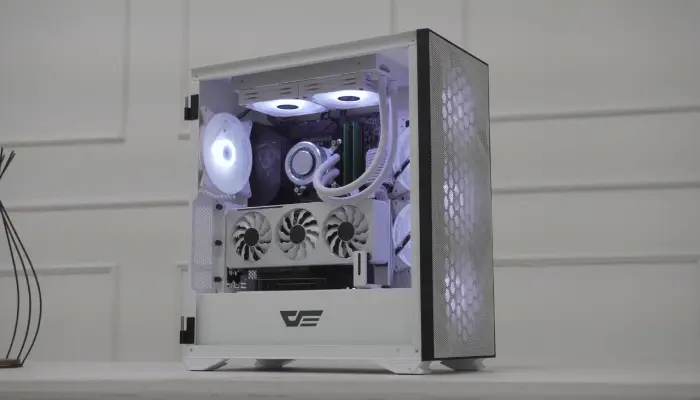
When building a PC, I usually recommend building it around the CPU or the GPU, since they are the central part of your build. In addition, they tend to automatically limit the rest of the computer’s parts. For example, you can’t buy an Intel motherboard if your processor is from AMD, and you can’t buy a medium case if your graphics card is the size of your arm.
In the case of the CPU, although it is essential, you don’t need to pay so much attention to the clock speed and cache of each processor. Instead, consider:
- If it has integrated graphics. If you’re going to add a discrete GPU, you can save $ by buying a non-graphics CPU
- The PCI express lines
- Noise level
- Gaming support, especially for new-gen stuff like the latest DirectX or Windows 11 OS
Keeping these things in mind is just as important as raw power. I recommend that you look for a CPU with at least a third-generation PCI express line because they are twice as fast as previous generations. This is quite good when transferring calculations, allowing for better gaming performance.
The GPU
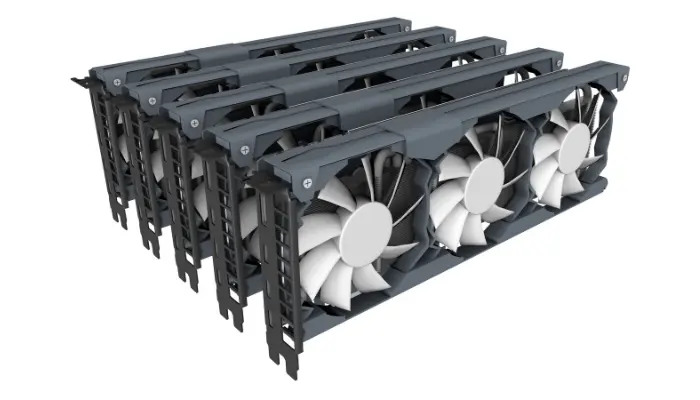
When it comes to GPU, my recommendation is simple: Don’t stick with individual reviews. Always look for comparisons between two similar GPUs because you can see exactly which is the best in certain sections. In other words, don’t just stick with the net power from the manufacturer.
Next, make sure it supports the games you want and the features they have. These can include stuff like raytracing, or optimization for certain titles. Dive into game forums and search for other players’ experiences with the card. For example, when Microsoft Flight Simulator first launched, it required no less than a 3070 to enjoy passable framerates while keeping the graphics at 2k. Successive updates have lowered the threshold to 3050, and players discover new tricks to balance performance and graphics fidelity.
Suppose you find that your two graphics card options are basically the same and have similar options. In that case, ideally, you should choose the one with more buffer memory. However, just make sure the memory is of good quality and fast. This is because some manufacturers use crummy memory to make the buffer appear larger.
The Motherboard and The RAM
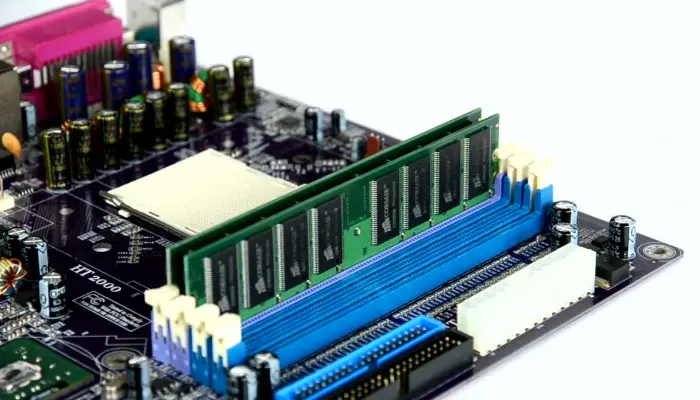
You don’t need to go for the most expensive option unless you’re looking to overclock your processor. There really isn’t much difference between chipsets from different brands. However, it is also not recommended that you buy the cheapest option. The cheapest chipsets usually have some artificial limitations such as ram speed, the possibility of overclocking, or the PCI bandwidth.
Ideally, the best option is a mid-priced motherboard with all the slots, sockets, and RGB ports you need.
When it comes to RAM, you have to consider three factors:
- Capacity
- Speed
- Timing
The higher the capacity, the lower the speed. Ideally, keep timing low, and strike a balance between speed (how fast the data moves) and capacity (how much data it can take into account).
Likewise, some CPUs prefer to work with specific types of RAM to lock their frequency to improve their performance.
Storage Drives, and Cooling
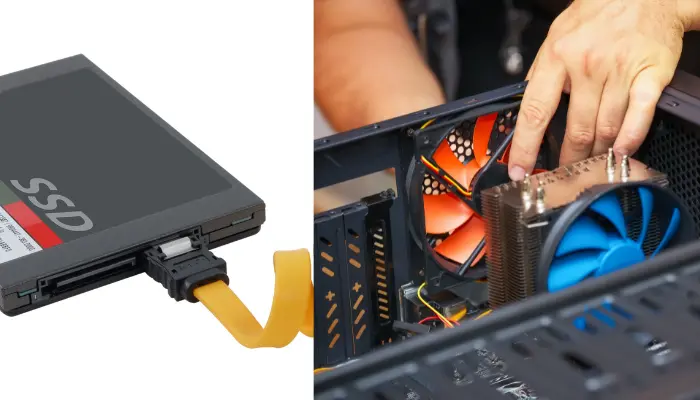
Concerning storage, today the idea is to look for solid-state drives. Although some still accept the old SATA interfaces, most use the nVME .2 interface. These newer drives are dramatically faster when it comes to data transfer and allow for better overall performance.
Most motherboards have at least two slots for each interface type, so it won’t really be a problem when installing. Ideally, you should always have a backup on hand, especially if your games are saved locally instead of on the cloud.
Regarding cooling, what you will see within the community is usually liquid cooling (which is really the most effective today without going into sub-zero cooling areas). If you are on a somewhat restrictive budget, consider fan placement and airflow to maximize air cooling without having to dip into the liquid territory.
Likewise, it is necessary to complement it with thermal insulation to toast the CPU. Really the only thing you have to make sure of is that it is a reputable brand and that you apply enough paste.
The Final Parts: PSU and Bling
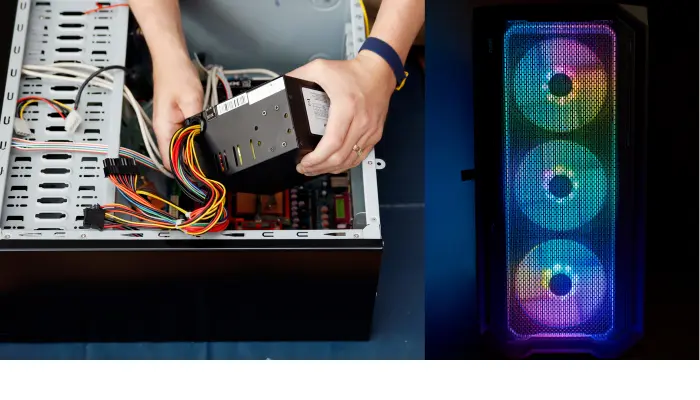
Many users neglect the PSU, that unsexy box that sits below the chassis. However, this is just as critical as the processor and GPU. If you buy an inadequate PSU or one that is too cheap, you may burn out the rest of your parts. The PSU is responsible for supplying power to the rest of the components, so it is one of the most essential parts.
If you have a mid-level build, you should pair it with a PSU with at least an 80 gold rating. It is also vital that it has a modular standard (usually more expensive but includes the possibility of changing parts) and a guarantee of at least 5 years of use.
Also note that the bigger the card and the faster the processor, the larger the power draw. So always have a comfortable “lead” in power, and not just the actual power draw of the system. Otherwise, your PC may shut off unexpectedly during demanding games or exciting fight scenes.
As for bling, that’s all on you. While not contributing to performance, they can make that anonymous tower pop out with the right lights and color combinations.
So there you have it, your first own-build gaming rig. Enjoy your new creation to the fullest, until it’s time to upgrade again!
Spread the love